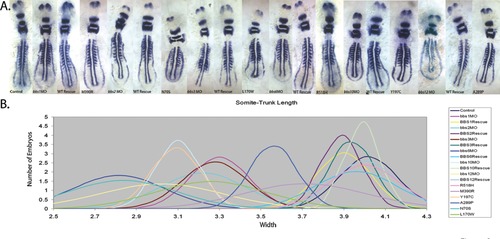Fig. S2
- ID
- ZDB-FIG-140811-26
- Publication
- Zaghloul et al., 2010 - Functional analyses of variants reveal a significant role for dominant negative and common alleles in oligogenic Bardet-Biedl syndrome
- Other Figures
- All Figure Page
- Back to All Figure Page
|
Quantification of somite stage phenotypes. Embryos co-injected with bbs MO and WT or mutant or mRNA were stained by in situ hybridization with pax2/krox20/myoD. Trunk length was measured from the first to the last appreciable somite to determine the extent of the shortened body axis phenotype. Embryos shown are representative examples of benign, hypomorph, null and dominant Negative mutations. (A) MO injected embryos were significantly shorter than uninjected control embryos, but co-injection of WT mRNA rescued the length defect. Consistently, mutations predicted null or dominant negative by live embryo scoring resulted in body length similar to morphants (e.g. BBS10 Y197C or BBS2 N70S, respectively) while those predicted to be Benign were similar to uninjected controls (e.g. BBS6 R518H). (B) The normal distribution of trunk length measurements shows the clustering of groups of effects for BBS1 and 2 (B), BBS3 and 6 (C) and BBS10 and 12 (D). Uninjected controls and WT rescue embryos are consistently longer, while MO and null and dominant negative effect mutations are consistently shorter (p≤0.001). Hypomorphic mutations (e.g. BBS12 A289P) are between the two. |

